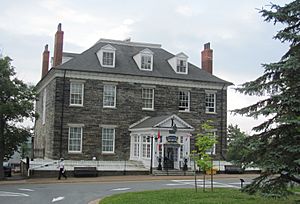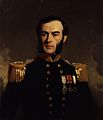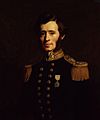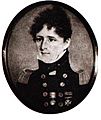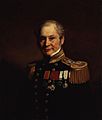Naval Museum of Halifax facts for kids
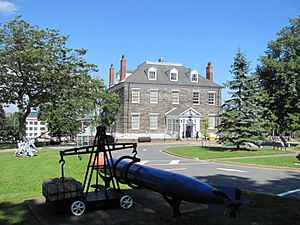 |
|
| Established | 1974 |
|---|---|
| Location | 2725 Gottingen Street, Halifax, Nova Scotia, Canada |
| Type | Naval museum |
The Naval Museum of Halifax is a special museum located at CFB Halifax in Halifax, Nova Scotia, Canada. It used to be called the Maritime Command Museum. This museum is inside a historic building known as Admiralty House. This building was once the home of the top British naval commander in North America. Today, the museum collects and shows items that tell the story of the Royal Canadian Navy. It helps us learn about Canada's naval history.
Contents
Admiralty House: A Historic Home
Admiralty House was the summer home for the admiral in charge of the British Royal Navy in North America. This was from 1819 to 1905. The large house was built starting in 1814. It has a grand style called Georgian architecture. It looks over the Halifax Naval Yard. Before this house, the commanders lived on their main ship.
The house was finished in 1819. It became the summer home for the Commander-in-Chief. In winter, the main naval base moved from Halifax to Bermuda. The first admiral to live here was David Milne.
Admiralty House was a very important place in Halifax. Many parties and special events happened there in the 1800s. One big party in 1848 had 600 guests! It was hosted by Admiral Thomas Cochrane. He was famous and inspired characters like Horatio Hornblower and Jack Aubrey in books. Another well-known person who lived there was Admiral Francis Austen. He was the brother of the famous writer Jane Austen. In total, 36 admirals lived in this house. The last one was Sir Day Hort Bosanquet.
In 1905, the Canadian government took over Admiralty House. This happened when Canada became responsible for the Halifax Dockyard. During World War I, the house was used as a naval hospital. On December 6, 1917, the roof was damaged by the Halifax Explosion. Even with the damage, the hospital staff helped many injured people right after the explosion. After repairs, the house became a clinic. It helped survivors of the explosion. From 1925 to 1954, it was part of the Royal Canadian Navy base HMCS Stadacona. It was used as an officers' mess and later for offices. In 1961, it became a library for the Royal Canadian Navy. It also had classrooms.
Famous Admirals Who Lived Here (1819–1905)
Many important admirals lived at Admiralty House. Some of them were involved in major historical events.
Admirals from the War of 1812
Two admirals who lived here were important during the War of 1812:
-
Edward Colpoys's ship, HMS Winchester, helped in 1814. He served in Halifax (1816–1821, 1830–1832).
-
Sir George Cockburn, 10th Baronet was involved in the Burning of Washington in 1814. He served in Halifax (1832–36).
Admirals from the Siege of Sevastopol
Four admirals who lived in Admiralty House fought in the famous Siege of Sevastopol (1854–55). This was during the Crimean War:
-
Edward Augustus Inglefield served in Halifax (1878–79).
-
John Edmund Commerell won the Victoria Cross for his bravery during the Siege. He served in Halifax (1882–85).
Admirals Who Searched for Franklin's Lost Expedition
Two admirals who lived here helped search for Franklin's Lost Expedition. This was a famous journey to find the Northwest Passage:
-
Edward Augustus Inglefield served in Halifax (1878–79).
-
Francis Leopold McClintock served in Halifax (1879–82).
Other Notable Admirals
-
Francis Austen, brother of Jane Austen. He served in Halifax (1844-1848).
-
Thomas Cochrane, 10th Earl of Dundonald. He inspired the character Jack Aubrey. He served in Halifax (1848–51).
-
Sir Alexander Milne, 1st Baronet. He was involved in the Trent Affair during the American Civil War. He served in Halifax (1860–64).
- James Hope (Royal Navy officer)
- Sir George Wellesley (1869–70, 1873–75)
Admiralty House officially opened as a museum on March 26, 1974. Rear Admiral D. S. Boyle opened it. The house was named a National Historic Site in 1978. The museum was updated with big renovations in 2009 and 2010.
The museum focuses on the history of the Canadian Navy from 1910 until now. It also covers the older history of the Halifax Dockyard. You can see the original bell and many items from HMCS Niobe. This was the first main ship of the Royal Canadian Navy. There are also displays of ship bells and special bells used for christenings. These bells show the history of the Canadian Navy.
More than 30 rooms of exhibits are open to visitors. Outside, you can see weapons and equipment from the Canadian Navy. The museum has uniforms, model ships, medals, badges, and other items from naval life. The museum also has a research library, old records, and a large collection of photos.
Museum Artifacts
-
The Order of Canada medal belonging to Laverna Katie Dollimore. She was honored for her role in the Iran Hostage Crisis in 1979.
The Royal Navy Burying Ground in Halifax has memorials for those who served. Many were lost or died in the medical facility. This includes those from the battle where USS Chesapeake was captured by HMS Shannon. There are 84 grave markers here. However, as many as 500 people are buried in this ground. It was a tradition for the Commander-in-Chief living in Admiralty House to create a grave marker for their crew members who died while at the station.
Admiralty Garden
On the grounds of Admiralty House, you will find the Admiralty Garden. It was created around 1814. It has plaques and monuments that honor admirals and other military people. In 1972, the "Wall of Valour" was added. It recognizes brave actions by members of the Canadian Navy and Naval Reserves. Those listed on the wall received awards like the Cross of Valour (Canada), the Star of Courage (Canada), and the Medal of Bravery (Canada). There are also plaques from the Historic Sites and Monuments Board of Canada that remember these admirals:
-
George Augustus Westphal - from the Battle of Trafalgar.
-
Provo Wallis - from the War of 1812.
-
Edward Belcher - involved in Franklin's lost expedition.
- George Edward Watts – from the War of 1812
- Philip Westphal – from the War of 1812
Museum Connections
The Naval Museum of Halifax is part of a group of 55 museums. These museums are run by the Canadian Department of National Defence. It is the largest naval museum in this system. The museum also works with the Canadian Heritage Information Network (CHIN). It also partners with Nova Scotia's Maritime Museum of the Atlantic. Together, they share the naval history of the region.
See also
- Military history of Nova Scotia
- List of oldest buildings and structures in Halifax, Nova Scotia
- Organization of Military Museums of Canada


